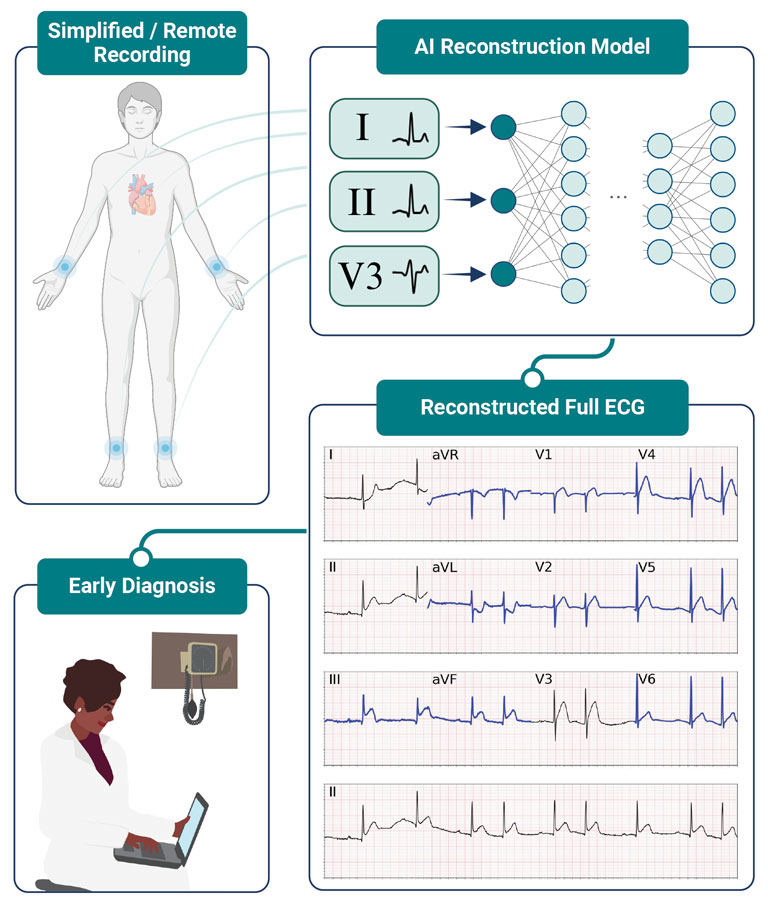
Co-authors Giorgio Quer, PhD, and Evan Muse, MD, PhD. Credit: Scripps Research
New AI tool simplifies heart monitoring: Fewer leads, same accuracy
Scripps Research scientists showed that, with help from an AI tool, cardiologists can diagnose heart attacks using a simpler, easier and more accessible electrocardiogram technology.
August 01, 2024
LA JOLLA, CA—To diagnose heart conditions including heart attacks and heart rhythm disturbances, clinicians typically rely on 12-lead electrocardiograms (ECGs)—complex arrangements of electrodes and wires placed around the chest and limbs to detect the heart’s electrical activity. But these ECGs require specialized equipment and expertise, and not all clinics have the capability to perform them.
Now, a team of scientists and clinicians from Scripps Research has shown that heart conditions can be diagnosed roughly as accurately using just three electrodes and an artificial intelligence (AI) tool. In a study published on August 1, 2024, in npj Digital Medicine, the scientists report that their AI algorithm can recreate full 12-lead ECGs with data from only three ECG leads. Moreover, clinicians can identify heart attacks with nearly the same accuracy when they review the AI-generated ECGs as compared to original 12-lead ECGs.
“This opens up the door to patients being able to get really high-quality, time-sensitive clinical data without traveling to somewhere that has a 12-lead ECG,” says cardiologist Evan Muse, MD, PhD, the lead of cardiovascular genomics at Scripps Research Translational Institute, assistant professor of Molecular Medicine at Scripps Research and co-senior author of the new paper. “It likely means not only increased access to ECG technology, but decreased costs and improved patient safety.”

Scientists and clinicians at Scripps Research have shown that heart conditions can be diagnosed roughly as accurately using just three electrodes and an artificial intelligence (AI) tool. Credit: Scripps Research
To build the new AI tool, the team used data from more than 600,000 12-lead ECGs that had been collected from patients. About half of those ECGs had normal health rhythms, while the rest had a variety of heart conditions. Giorgio Quer, PhD, director of artificial intelligence at Scripps Research Translational Institute, assistant professor of Digital Medicine at Scripps Research and co-senior author of the paper, then began testing which combinations of just two or three electrodes could be used for AI to fully recreate the 12-lead data.
“We knew that leads are somehow related. Deep learning algorithms allowed us to process a very large dataset and understand these relationships among the leads, enabling the reconstruction of the full 12-lead. We started out hoping to get a full reconstruction from just limb leads, because those are the easiest for non-specialists to set up,” says Quer. “But we found that we got much better data when we added a chest lead as well.”
The researchers then took a set of 238 ECGs, with half showing signs of a heart attack. They showed cardiologists either the original 12-lead ECG or an ECG reconstructed by AI using data from the three selected leads. The cardiologists could not identify which was which, and they also correctly identified heart attack indicators 81.4 percent of the time in the AI-generated ECGs—very close to the 84.6 percent accuracy of original 12-lead ECGs.
“It was important to us that we not only show that this algorithm works at a technical level, but that the data generated by the algorithm can be accurately interpreted by cardiologists,” says Quer.
The researchers say that before the algorithm can be used for clinical decision making, prospective studies will be needed with different patient populations and in different clinical settings. However, if the tool continues to perform well, it could open the door to ECGs being carried out in new settings with less specialized equipment and clinicians—and for patients, that means faster diagnoses and treatments.
“This is an optimal case for AI—taking a few leads of the (12-lead) electrocardiogram—to make it remarkably informative, which has big practical implications for patients in the future,” says Eric Topol, MD, director and founder of the Scripps Research Translational Institute and executive vice president of Scripps Research.
The research is part of a growing portfolio of work that expands the use of AI tools in screening for and diagnosing heart conditions. In 2023, Quer’s group reported that a single ECG patch worn for two weeks could help determine which patients were most at risk of atrial fibrillation.
“This new work is just one example of how we can use AI to enable things that we could never do in the past,” says Quer.
In addition to Quer, Muse, and Topol, authors of the study, “AI-Enhanced Reconstruction of the 12-Lead Electrocardiogram via 3-Leads with Accurate Clinical Assessment,” are Federico Mason, Amitabh Pandey and Matteo Gadaleta of Scripps Research.
This work was supported by funding from the National Institutes of Health (UM1TR004407 from the National Center for Advancing Translational Sciences and R21AG072349 from the National Institute on Aging).
For more information, contact press@scripps.edu

